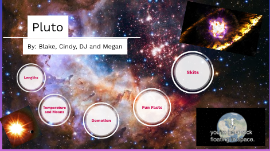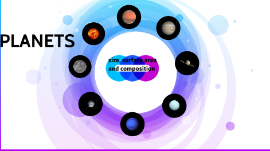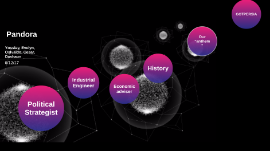Planet Presentation
Transcript: size, surface area and composition PLANETS Mercury, the innermost planet of the solar system, is a little bigger than the Earth's Moon. The surface of the planet is covered with craters, like the Moon, but temperatures there can reach over 800oF because Mercury is so close to the Sun and rotates so slowly. MERCURY source: https://www.windows2universe.org/mercury/Interior_Surface/Overview.html Scientists believe that the interior structure of Mercury includes a metallic core, an intermediate rocky layer, and a thin brittle crust. The composition of Mercury is probably high in iron, although surface features indicate that volcanic activity once existed at the surface. There is little evidence of motions near the surface of the planet now, although at earlier times during Mercury's evolution the surface was much more active. We know relatively little about Mercury, compared to most of the other planets, because it is relatively difficult to see and only one spacecraft has studied the planet. Mercury Mercury Size7; 1,516 mi Surface: The surface of Mercury has numerous interesting features, including a variety of craters, ridges, and terrains ranging from heavily cratered to nearly crater free. These features, and their location across the known planet surface, helps us to understand the evolution of the planet. Composition: Scientists believe that the interior structure of Mercury includes a metallic core, an intermediate rocky layer, and a thin brittle crust. The composition of Mercury is probably high in iron, although surface features indicate that volcanic activity once existed at the surface VENUS Compistion: The surface of venus is covered with lots of volcanoes and has a very rocky crust and is full of canyons trenches and mountains. Like mars it doesn't have any tectonic plates because they were believed to be melted together forming one solid crust. It also has a very thick atmosphere so only the largest meteor could make it to the planet before burning up completely. The surface temp is hot enough to melt lead that has a melting point of about 621 degrees fahrenheit. Surface 460240887 kilometers Size mean radius of 9738.355 kilometers Citations https://www.space.com https://www.space.com MARS Mars Compistion:Mars surface is made of a rusty iron dust and rocks beneath the surface it is mostly made of volcanic basalt rock the crust is about 30 miles thick. Unlike earth mars has no tectonic plates but that doesn't stop volcanoes from forming so the molten rock can escape Surface 144371391 square kilometers Size: Mars has mean radius of 5454.5149604 kilometers https://www.space.com https://mars.nasa.gov/allaboutmars/facts/#?c=theplanet&s=size Citations https://www.space.com https://mars.nasa.gov/allaboutmars/facts/#?c=theplanet&s=size JUPITER Jupiter is the largest planet in the solar system. It is approximately 143,000 kilometers (about 89,000 miles) wide at its equator. Jupiter is so large that all of the other planets in the solar system could fit inside it. More than 1,300 Earths would fit inside Jupiter. jupiter is like a star in composition. If Jupiter had been about 80 times more massive, it would have become a star rather than a planet. CITATION https://www.space.com/g00/18392-how-big-is-jupiter.html?i10c.encReferrer=aHR0cHM6Ly93d3cuZ29vZ2xlLmNvbS8%3D&i10c.ua=1 SIZE Jupiter SIZE: Size:43,441 mi Jupiter has a mean radius of 43,440.7 miles (69,911 kilometers), about a tenth that of the sun. CITATION: https://www.space.com/g00/18392-how-big-is-jupiter.html?i10c.encReferrer=aHR0cHM6Ly93d3cuZ29vZ2xlLmNvbS8%3D&i10c.ua=1 SURFACE AREA, COMPOSITION Jupiter SURFACE AREA: Surface Area: 23.71 billion mi² COMMPOSITION: Composition:Composed predominantly of hydrogen and helium, the massive Jupiter is much like a tiny star. But despite the fact that it is the largest planet in the solar system, the gas giant just doesn't have the mass needed to push it into stellar status. SATURN Size:36,184 mi surface area: 16.49 billion mi Composition: Saturn seems to have a hot solid inner core of iron and rocky material surrounded by an outer core probably composed of ammonia, methane, and water. Next is a layer of highly compressed, liquid metallic hydrogen, followed by a region of viscous hydrogen and helium. Extra info The Romans regarded Jupiter as the equivalent of the Greek Zeus, and in Latin literature and Roman art, the myths and iconography of Zeus are adapted under the name Iuppiter. In the Greek-influenced tradition, Jupiter was the brother of Neptune and Pluto, the Roman equivalents of Poseidon and Hades respectively. Saturn Extra info The Great Red Spot is a giant, spinning storm in Jupiter's atmosphere. It is like a hurricane on Earth, but it is much larger. Jupiter's Great Red Spot is more than twice the size of Earth! Winds inside this storm reach speeds of about 270 miles per hour. http://coolcosmos.ipac.caltech.edu/ask/91-What-is-the-Great-Red-Spot-on-Jupiter- Saturn URANUS The seventh planet from the sun

















